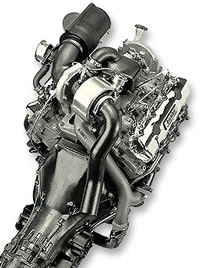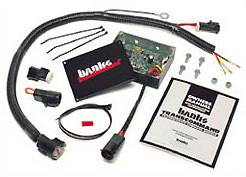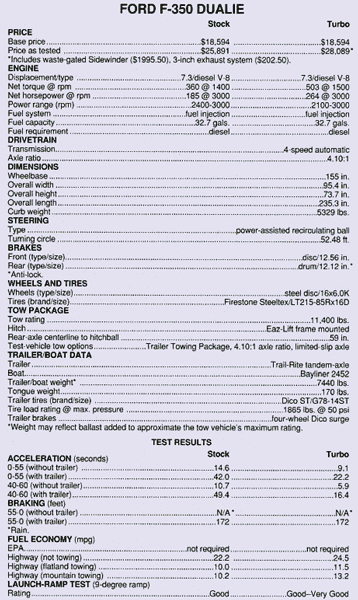Tow Test: Ford F-350 Diesel Stock vs. Turbo
Trailer Boats December 1996
Ford 6.9/7.3L diesel trucks
If you think diesels are slow, you’re right—but what happens when a Gale Banks turbocharger is added to the same truck?
The Ford 7.3-liter (444-cubic-inch) V-8 is the largest, most-powerful, non-turbocharged diesel engine offered in light trucks. Built by Navistar—the maker of International heavy-duty trucks—it has a successful reputation in heavy-duty, commercial International trucks as well as in Ford pickups.
At one time, this engine far and away outsold its competition—the Chevrolet/GMC 6.2-liter V-8. But, then, along came desperate Dodge Truck Division, which needed to add some adventure into its antiquated product line—so it introduced a turbocharged diesel with the famed and trusted Cummins name. Suddenly, the Ford diesels lost a giant chunk of their sales, but have still maintained diesel supremacy.
Why the sudden interest in turbodiesels? Well, it gives a trailer tower much better fuel economy and towing performance that’s equivalent to a gasoline-powered big-block V-8.
Both Ford and General Motors had investigated turbocharged diesels long before Dodge’s daring move. But, since diesels weren’t overwhelmingly accepted by the driving public, they believed that adding $2000 for a diesel, then another $2000 for a turbocharger option, wouldn’t sit well with a cost-conscious America—especially since diesel fuel prices were higher than gasoline at the time and diesel pumps aren’t as common in gas stations as they once were.
But the Dodge/Cummins impact on the market was so significant that Ford and General Motors had to regroup quickly. Chevrolet and GMC introduced the 6.5 turbodiesel last year, and now Ford is beginning to offer a turbodiesel. But, with the initial Ford turbodiesel models, you won’t be able to get air conditioning.
If you’ve ever wondered why gasoline-powered engines with turbochargers don’t have tow ratings and why turbodiesels do, the answer is simple—gasoline-powered engines produce much more heat. In a gasoline engine, exhaust gas temperatures can be four to five times greater under light loads and twice as great under heavy loads than in a diesel. Too much heat can seriously damage many parts of an engine.
In addition, diesel engines for heavy-duty applications, such as the 7.3, are built much stronger and are heavier than their gasoline counterparts. The crankshafts and the bottom-end webbing are tougher, as are the bearings, to withstand a diesel’s high compression and loads. Consequently, when a turbocharger is added to a diesel engine, it can usually handle the extra torque and horsepower that a turbo adds. That’s a not always true with a gasoline engine.
Turbodiesel longevity has been very good. It’s successful operation has been documented for years by the cost-conscious freight companies whose 18-wheelers log more miles in a month than the average passenger-car driver might total in a year.
If you are wondering just what kind of performance difference there is between a stock diesel and one that’s been turbocharged, here’s your chance. Gale Banks Engineering gave me the opportunity to make such a test with a new Ford F-350 SuperCab dualie. I first ran this test with a stock 7.3 diesel, then Gale Banks added its Sidewinder turbocharger. So, this gave me the opportunity to test the same truck/engine combination both ways.
The Test Truck
The Ford F-350 SuperCab used in this test was a very plush, well-optioned truck. I like those kind, but not all of us have that kind of discretionary income. It came with front bucket seats separated by a highly utilitarian center console. The seats were a great asset, because a Ford one-ton truck is a firm-riding vehicle. And the rear bench seat actually has reasonable comfort, but not an awful lot of legroom. Nonetheless, the longer cab allows better front-seat adjustment and offers a great interior storage area that is more secure and weather-resistant than the open pickup bed.
The SuperCab model comes on a longer wheelbase—in this case, 155 inches—which is a big asset when towing, as are the dual rear wheels. And both were important in many phases of two towing tests conducted with this truck.
The truck came with a heavy-duty towing package, which includes Super Engine Cooling, an auxiliary automatic-transmission oil cooler, heavy-duty battery, trailer wiring harness, heavy-duty flasher and a handling package. Ford’s towing package does not include a hitch, so our test truck had an Eaz-Lift weight-distributing that Gale Banks had installed. Because of the dual rear wheels, stability was so good that a weight-distributing hitch was not needed. However, be aware that, if you’re towing heavy weights without a weight-distributing hitch, you may be exceeding both the vehicle and hitch manufacturers’ towing recommendations.
Dualies have a few disadvantages. You must be aware that the truck is wider, otherwise you’ll drift out of your lane and run over a lot of curbs. It’s not easy to park in a supermarket lot, which has parking lanes that have suddenly become narrow with your wider vehicle. And the dualies are so wide that you can’t get a good view of the trailer tires from the sideview mirrors. I’m a bit paranoid about not being able to see trailers, because I’ve lost a few tires and a wheel while testing.
The towed load was 7440 pounds. It consisted of a Bayliner 2452 cruiser and a Trail-Rite tandem-axle trailer with four-wheel Dico surge brakes.
The Stock Engine
Ford does a pretty good job of insulating diesel noise from the passenger compartment, so it’s reasonably quiet inside while driving. Though nontowing performance isn’t spectacular, it’s pretty decent—especially when you can get 16 to 18 miles per gallon (mpg) around town and better than 20 mpg on the open road. That’s pretty good with a big truck.
But driving a diesel takes patience. The big 7.3 V-8 has enough torque and horsepower to pull a sizable load, but it will only do it at its own pace. You can’t hurry it, because pushing the throttle pedal to the floor won’t improve it’s performance – it’ll just worsen fuel efficiency.
When not towing with the stock engine, I found myself downshifting from overdrive on overpasses because speed would drop by five or 10 mph. In overdrive at 55 mph, engine rpm is 1900 rpm, while in third it registers 2600 on the tachometer. Though peak torque comes in at 1400 rpm, I found that the engine didn’t begin working well under load—going uphill or when towing—until about 2400 rpm.
With the 7440-pound boat, I could tow in overdrive at highway speeds, but only if it was perfectly flat. On the uphills, you need patience. Speed drops quickly, but you can’t use second gear until about 40 mph, because the engine is rpm limited. The engine governor comes on about 3300 rpm, so the engine won’t run much faster. In fact, I began to notice a performance slow down at about 3100 rpm as the governor gradually began to engage. This was true with the turbocharged version, too. When downshifting from third to second at 40 mph, the tachometer reads 3000.
The engine held speeds in the mid-30-mph range. That’s not startling, but it does it with relative ease; in other words, it’s not struggling, as you might suspect. Best of all, I got four- to five-mpg better while towing than I got with big-block gasoline V-8s with this kind of load.
This truck had the optional 4.10:1 axle ratio. When towing a heavy load, I’d certainly opt for that ratio—especially for the launch ramp. I’ve had terrible problems trying to retrieve boats with a stock 7.3 diesel using a 3.55:1 axle ratio.
Ready for a few surprises? Read on.

The Gale Banks Sidewinder turbo is designed to run at a slow rpm. Consequently, you need to tow in overdrive. Quite an eye-opener!
The Turbocharged Engine
I lowered acceleration times by five seconds when not towing and up to 30 seconds when towing. I also improved non-towing and flatland-towing fuel economy. That was with the turbocharger added. Take a look at the “Diesel Comparison Chart” I’ve included.
Also, I picked a five-mile-long, five-percent grade to run a towing torture test with the turbocharged engine by running it wide open and with the air conditioner on, just to find out how many gauges I could get into the red. Turbo boost went to 9.25 psi (the Gale Banks unit is rated for up to 10.5 psi), exhaust gas temperature reached 800 degrees, engine-oil temperature was 250, the Ford coolant gauge got as high as “A” in “NORMAL” (it never got hotter than “M” during normal towing) and the transmission showed a surprising low of 190 degrees. Though higher than normal, those temperatures were well below any danger points. And, as I was to learn later, it would have been better if turbo boost and exhaust temperature were hotter.
The truck took on a whole new character, now that it was turbocharged. Other than the rattle of the diesel, it performed much like a big-block, gasoline powered V-8 when not towing. But, unlike a gasoline engine, it was substantially more fuel-efficient.
Many people believe that there’s a trade-off when you add a performance option—more power but less fuel economy. In general, that’s true, but it depends on your choice of performance option. When a turbocharger is added to a diesel, it makes it run with less effort, consequently it does not need to use more fuel. That’s also true when you add a better-flowing exhaust—a Gale Banks exhaust system was on this truck.
There was one puzzling result from the test, however. I expected the turbocharged engine to get better fuel economy in the mountains, but it didn’t. It got 9.6 mpg. I was able to use third gear on most uphills—except the steepest ones—while I had to use second all the time with the stock diesel. That, in itself, should have improved fuel economy, as it did in previous turbo tests I’ve done. My first inclination was that, because I used two different stations to dispense the diesel fuel, maybe one of those pumps hadn’t been maintained properly. An improperly maintained pump can produce a greater foaming action when dispensing fuel.
Also, the mountain towing figures I got with the turbodiesel showed only a 1- to 5-mph improvement while climbing the grades over that stretch. Again, based on previous turbodiesel tests, this showed a lesser improvement over stock than I had experienced before.
As with all my tow tests, I used the “power range,” as I have always done, and I never used overdrive, except during the flatland run. I did notice, however, that the power range came in at 300 rpm lower with the turbocharged engine. That made me quizzical, too.
While running the test-route uphills in the power range, instead of flat out, as I did in the torture test, the gauge readings were lower. Turbo boost was 6 to 7 psi, exhaust temperature was 600 degrees, engine oil temperature was 220 and transmission oil temperature remained a cool 190.
I called Gale Banks with the results, because the results just didn’t seem right. Well, that was an inspirational telephone call, because I got a whole new look at the new generation of turbodiesels from Gale Banks Engineering.
Unlike factory turbodiesels I tested, including earlier Gale Banks models, the new Sidewinder is a waste-gated model that’s designed to develop peak torque at a low rpm—1400 to 1500 rpm—yet maintain high torque all the way up to the governor speed. For peak operation of this turbo, it’s critical to keep engine speed down. As you know, that’s contrary to normal towing with all other light-duty engines, including factory turbodiesels. So, in ignorance, I maintained higher rpm and conducted my normal tow test.

The E4OD automatic transmission in bigger Ford trucks is designed with slippage built in for smoother shifts. However, when extra power or heavy trailer loads are added to the transmission, that slippage increases temperatures and transmission wear. To counteract these problems, Banks Engineering’s Transmission Command Module (TCM) produces quicker shifts without taking away the smoothness. In this test, it also resulted in better transmission performance and kept temperatures to a surprisingly low 190 degrees, which is better than I’ve come to expect from a stock, factory transmission when towing.
After my phone call to Gale Banks, I was instructed to keep it in overdrive, run at normal highway speeds when towing—55 and 65 mph—and keep turbo boost near 10 psi and exhaust temperature near 1000 degrees. That was a hard learning curve to swallow, because those kinds of techniques often lead to quick engine failure. But I was willing to try. What made matters more confusing was that only part throttle was needed to do this.
I made arrangements with Gale Banks Engineering to tow a special trailer that was only 10 pounds lighter than the boat/trailer combination I used in the original test.
By keeping it in overdrive, the engine maintained the much-needed lower rpm, turbo boost got as high as 10.5 psi and exhaust temperature went up to 1050 degrees F, which is about 600 degrees cooler than the exhaust temperature you’d expect of a gasoline engine when under load.
The results were mind-boggling. Everything held together. The vehicle could maintain 55 mph on all the upgrades while using overdrive, but dropped to a low of 50 mph on the six percent grade; that was the only time third gear was needed. On all but the steepest upgrades, speeds could be brought up to 60 and 65 mph. Besides the performance improvement, mountain towing economy went from 9.6 mpg to 13.2 mpg, which was more consistent with previous turbodiesels I have done.
Driving the Gale Banks turbodiesel in a lower gear caused the engine to reach a speed where the governor began to cut in—thus, the engine is rpm limited. Banks’ way of bypassing the governor was to introduce peak torque sooner and produce volumetric efficiency at a low engine speed, as long as the engine can handle a heavy towed load—with the Navistar/Ford diesel, that was possible.
One of the things that make the Sidewinder’s low-rpm performance possible, according to Banks, is Ford’s E4OD automatic transmission—it runs very cool. Transmission temperatures during this test never exceeded 190 degrees F, which was utterly amazing to me.
 The E4OD performed quite well in this test. It downshifts and upshifts very smoothly, even when shifted manually. But, most of all, it ran cool. Gale Banks engineers tell me that, in their tests, it appeared that the torque converter locked up in all gears, including first. Many of today’s automatics only lock up in third and fourth gears. One of the benefits of a lockup torque converter is that it reduces transmission slippage, thus the transmission runs cooler and more efficiently.
The E4OD performed quite well in this test. It downshifts and upshifts very smoothly, even when shifted manually. But, most of all, it ran cool. Gale Banks engineers tell me that, in their tests, it appeared that the torque converter locked up in all gears, including first. Many of today’s automatics only lock up in third and fourth gears. One of the benefits of a lockup torque converter is that it reduces transmission slippage, thus the transmission runs cooler and more efficiently.
The engineers also recommended to leave the transmission in overdrive at all times, because the E4OD does such a good job of up and downshifting on its own.
The Bottom Line
From a performance and fuel-economy standpoint, a turbodiesel has many positive advantages over a stock diesel, as the results show. But do you really recoup your investment?
The $2000 retail price of the Gale Banks turbo, plus installation charges (unless you do your own), is a substantial investment.
It’s been estimated that it would pay for itself in fuel savings alone by the time the odometer reaches the 100,000 mile mark. And, unlike a gasoline-engine turbo, a diesel turbo generally has a life expectancy in excess of 100,000 miles. If that’s true, the worst you could do is break even….and have better performance in the meantime.
I can tolerate a diesel’s grudging performance if I were interested in engine longevity and fuel economy. But, I must say, I appreciate it tenfold when it can get me from a stoplight quickly and safely pass that turtle on a busy two-lane road.
The comparison figures speak for themselves.

